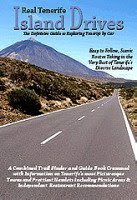A comment on the previous blog mentioned the east and the west of Tenerife and asked what about Los Gigantes?
That blog was about visitors’ general perceptions of Tenerife – which sometimes are condensed into simplified questions about north and south and as a result don’t paint an accurate picture of the island as a whole.
It would be possible to write reams and reams about why to talk about the island in terms of points of the compass can be misleading when taken out of context. There are far more complex issues involved that go beyond the differences in climate; although climate does usually play a role, but not in a 'is it nice enough to sunbathe' sort of way.
So what about the east and the west?
First the west. There is a world of difference between the western towns on the northern side of the Teno Mountain range and those on the southern.
In many ways the resorts on the south west coast are a microcosm of the Los Cristianos, Las Américas and Costa Adeje area.
Just as Los Cristianos existed as a tiny fishing community before tourism, so did Puerto Santiago. Los Gigantes and Playa de la Arena, like Las Américas and Costa Adeje, are the invention of developers and didn’t exist before a hotel was built. Think about this, Playa de la Arena in English simply means ‘sandy beach’.
It doesn’t mean that they’re not nice places to visit or live; they enjoy the best of Tenerife’s sunshine. However, in days gone by noblemen, wealthy merchants and artists chose the towns on the other side of the mountain range to set up home. It’s on the north western coast in places like Buenavista del Norte, Los Silos and Garachico that travellers can still discover a Tenerife that wasn’t created to satisfy the demands of the tourist industry.
In many ways the other end of the island, the east, is even more interesting. The capital Santa Cruz and former capital, La Laguna are located there (well…north east) and that metropolitan area is home to the greatest concentration of residents on the island. But you wouldn’t know that from much of what you read about Tenerife in tourist brochures or even in the British media.
La Laguna was an ecclesiastical centre and a seat of learning. Its old quarter is a World Heritage Site and is full of beautifully preserved colonial architecture. But that doesn’t mean it’s simply a haven for people who like old buildings and museums. It is home to the university and bars and restaurants exude the youthfulness and vibrancy that you find in university towns. Santa Cruz, the political and business hub of the island, is no different – there’s a reason why most major music concerts take place in the capital. Look in the Spanish press at live music venues and you’ll hardly see a mention of tourist resorts, instead listings will be mainly in these two places…even though Las Américas is the place dubbed the nightlife centre of Tenerife.
In nearly every way, Santa Cruz and La Laguna are the true centres of Tenerife’s world…but not when it comes to tourism. In tourism terms they just don’t hold the same draw as the resorts and that can make them almost invisible to many visitors.
Here’s a little fact which really illustrates how La Laguna’s role in tourism has changed with the rise of mass tourism. In 1864, there were at least six hotels in La Laguna. Nowadays, with all the millions of visitors that descend annually on these shores, there are a grand total of two.
It’s interesting that what attracted the artists, explorers and adventurers holds limited interest for the majority of the mass tourist market. On the bright side, it means that those who still possess a spirit of exploration and adventure have much to discover away from the sun, sand and sangria scene.
Say Halo Halo Halo For Saintly Memories
7 months ago




No comments:
Post a Comment